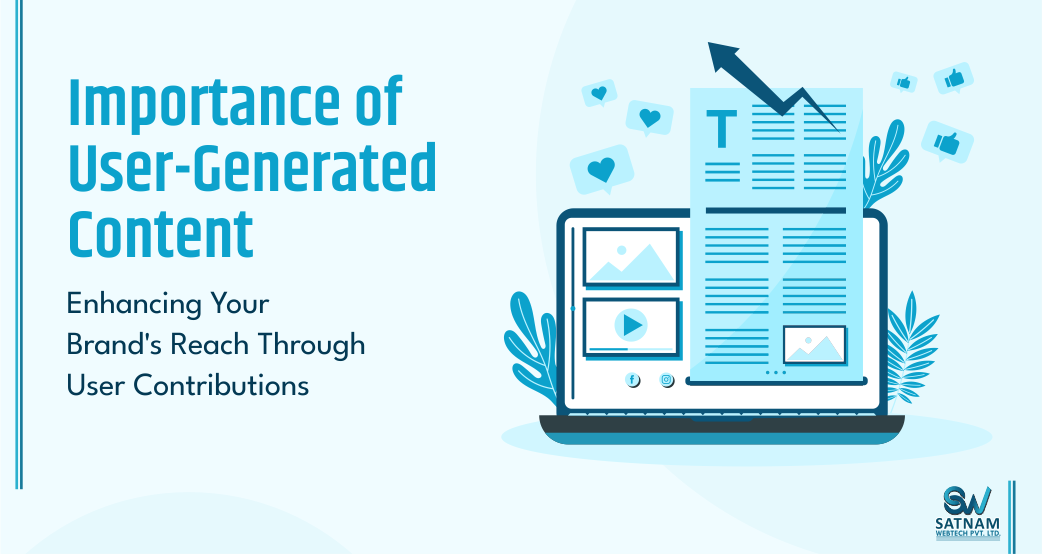
Did you know?
84% of buyers trust suggestions from their peers over all types of advertisement.
After the evolution of digital marketing, a few common strategies we knew have been felt saturated, and consumers have nothing new to consume. This shift has brought in new demand to ignite emotions within marketing. As a result, content is fueled up with storytelling, video marketing has now more to serve and intuitions and user behaviour have been given more weightage. The same has ignited the need for UGC, i.e. user-generated content, an innovative part of search engine optimization.
UGC is more than just a trending marketing tool; it’s a powerful asset that provides brands with authentic, relatable insights directly from consumers. The essence of UGC lies in the genuine trust and engagement it builds, which are essential qualities for brands aiming to connect on a deeper level with their audience. It’s a crucial part of any marketing strategy, especially as consumers increasingly seek peer feedback to influence their purchase decisions.
The Role of User-Generated Content in Building Trust and Credibility

UGC promotes credibility because it comes directly from real users, offering unbiased insights that make your brand more relatable and trustworthy. Here’s how UGC builds that essential trust:
- Real Customer Testimonials: Consumers are more likely to believe in authentic testimonials. Example: A clothing brand sharing customer reviews on product pages shows real feedback on fabric quality, fit, and durability.
- Authentic Social Proof: UGC is viewed as unbiased, increasing authenticity and user trust. Example: A skincare brand that regularly reposts user selfies and reviews to show how its products work on real skin.
- Greater Relatability: UGC often mirrors the language of potential customers, making your brand feel more approachable. Example: Fitness brands showcasing real transformations and progress photos shared by their community members.
Enhancing Brand Visibility with User-Generated Content

UGC is an excellent way to organically boost your brand’s reach by connecting with larger audiences through real customer experiences. Consider the following benefits:
- Organic Reach Through Shares: When customers share their positive experiences, it reaches their friends and followers, increasing brand visibility. Example: A travel agency encouraging customers to tag them in vacation photos, which are then shared, expanding reach.
- Higher Engagement on Social Media: UGC often sees higher engagement as it is relatable and resonates with followers. Example: Food brands encourage users to share recipes made with their products, leading to interactive, engaging posts on Instagram.
- Improved Brand Perception: Reposting UGC on social media can build the perception that the brand values customer feedback. Example: A car rental company showcasing user photos and reviews, demonstrating customer satisfaction across different locations.
UGC and Its Impact on SEO

Image source- Wordstream
User-generated content provides valuable SEO benefits by keeping your website fresh, relevant, and rich in unique content. When paired with a structured SEO optimization checklist and powerful social strategy, UGC becomes a tool not only for visibility but also for strengthening brand loyalty and enhancing trust. Here are a few ways UGC supports search engine optimization:
- Fresh Content Adds Relevancy: Regular user reviews or forum discussions contribute to your website’s relevancy, helping with search rankings. Example: A tech brand with a dedicated section for users to discuss their experiences with new gadgets.
- Natural Keyword Incorporation: UGC often includes long-tail keywords that resonate with search intent, improving SEO organically. Example: A restaurant website where guests leave reviews like “best pizza in New York” or “romantic dinner spot.”
- Enhanced Visibility with User Reviews: Google values websites that showcase real feedback, giving priority to those with user-generated content. Example: An e-commerce site showcasing detailed user reviews and ratings directly on product pages.
Common Mistakes People Make with User-Generated Content
User-generated content (UGC) can be a game-changer, but it requires careful handling to maintain authenticity and impact. Here are some common mistakes brands make when managing UGC, and how to avoid them:
- Over-Filtering and Editing Content: While it may be tempting to edit UGC to match your brand’s tone, too much modification can strip away its authenticity.
Example: A travel agency heavily edits user photos and reviews, making them look staged rather than genuine experiences. Instead, brands should aim to retain the natural feel of UGC to preserve trust.
- Ignoring Permissions and Copyright: Using UGC without explicit permission can lead to legal issues and damage the brand’s reputation.
Example: A restaurant reposts photos from diners without asking, causing customer dissatisfaction. Brands should always request permission before sharing user content and give credit to the creators.
- Lack of Engagement with UGC: Failing to interact with users who create content for your brand can discourage future engagement.
Example: A fashion brand receives tagged photos from customers but never acknowledges them, missing out on relationship-building opportunities. Brands should like, comment, or even reshare UGC to foster a community.
- Neglecting Negative or Constructive Feedback: Brands often focus only on positive UGC, overlooking constructive criticism that could improve brand perception.
Example: A skincare company shares only glowing reviews, ignoring helpful feedback on product adjustments. Embracing constructive UGC shows customers that the brand values transparency and customer insights.
- Overloading Campaigns with UGC: Excessive use of UGC can dilute its impact, making it appear less genuine over time.
Example: A brand’s Instagram feed consists entirely of UGC, reducing the space for original, curated content. Instead, balance UGC with branded posts for a well-rounded strategy.
Avoiding these common pitfalls allows brands to make the most of UGC while maintaining genuine connections and a positive customer experience.
How to Effectively Encourage and Use UGC
Brands can harness the power of UGC by encouraging satisfied customers to share their experiences through various forms of media. Creating a branded hashtag, offering incentives, or highlighting user content in social posts can effectively drive engagement and participation. Once UGC is flowing, prioritize using it strategically: feature authentic customer stories on your website, share testimonials across your social media marketing services, or spotlight real users in promotional campaigns.
Remember that user-generated content should be part of a larger, cohesive strategy, providing value and context for your audience.
Conclusion
To make UGC a meaningful part of your marketing strategy, focus on authenticity, relevance, and consistency. By integrating customer voices into your messaging, you can bridge the gap between marketing promises and customer experiences, a critical touchpoint in converting and retaining your audience.
Curious about incorporating UGC into your digital marketing strategy? Satnam Webtech can help you navigate the process, ensuring it aligns seamlessly with your goals. Reach out today and discover how we can elevate your brand through authentic connections.